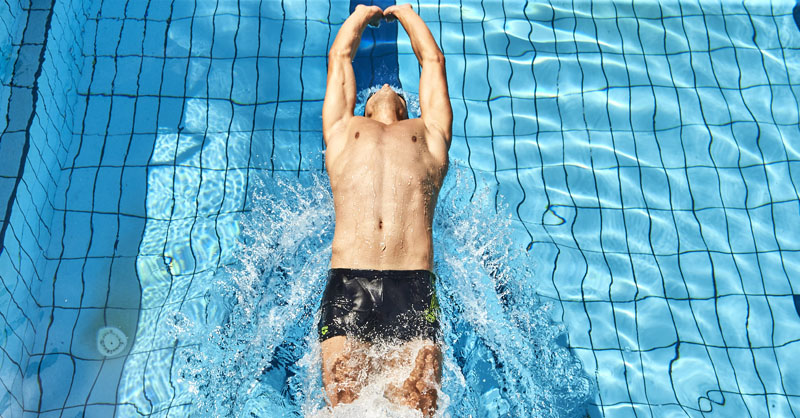Level: beginner
Unlike the other three competitive swim strokes, the backstroke is the only one swum on your back for the entire race. This means that a good sense of direction is important as well as coordination.
Historical overview
Nobody really knows how the backstroke came into being; it was only introduced into competitions in 1906 and was swum with one synchronised backward rotation of both arms with a breaststroke leg kick until 1914.
Body
Keep your body straight with your legs slightly lower than your upper body, so that they can work properly. It is important to keep your body rolling around the horizontal axis while swimming the backstroke to ensure the right arm movement.
Legs
The leg kick is very similar to the freestyle, an alternating fluttering movement with your knees bent and feet pointed. The legs serve two purposes:
- Stability: they help you keep a good buoyant position in the water, counterbalancing the lateral-negative action of the arms
- Propulsion: they provide more forward propulsion than the leg kick for the crawl.
Arms
The arms contribute most of the forward motion as they sweep backwards in two phases:
- The power phase: this is when the arms work underwater in an extended-flexed-extended sequence. The edge of the back of the hand enters the water first (arm extended) sweeping downwards to a depth of approximately 45 cm before your elbow starts to bend to allow the hand to be in the right position to pull towards your thigh-bottom before extending again.
- Recovery: your hand sweeps out of the water in a circular backwards movement (semicircle) and extends beyond your head.
Breathing
You should breathe at a rhythm of one full breath for each complete arm movement: breathe in through the mouth during the recovery phase and out through the nose-mouth during the power phase.
Turn
You turn “onto your stomach” as you approach the wall, following your arm action ready to perform a half tumble turn and then push off in the opposite direction. You are not allowed to make any other movements after returning to the prone position before making the tumble turn.
You can stay underwater on your back and with your arms extended above your head for a distance of 15 metres from the wall, kicking simultaneously with both legs in one single repeated kick (like the butterfly).
It is not easy to swim without being able to see where you are going, but swimming is like music: you cannot see it, but you can feel it!
